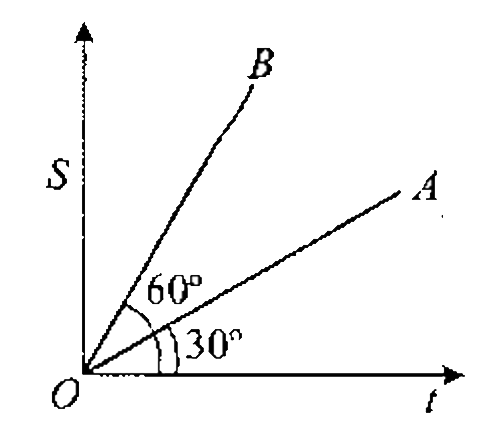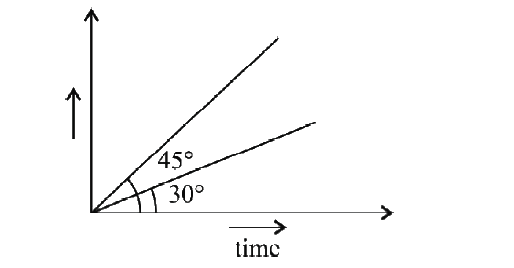Completion type Question : The v-t graphs of two objects make angles of and with the time-axis. The ratio of their accelerations is ………..
To find the ratio of the accelerations of two objects based on their v-t (velocity-time) graphs, we can follow these steps:
Step 1: Understand the relationship between slope and acceleration
In a v-t graph, the slope of the graph represents the acceleration of the object. The slope can be calculated using the tangent of the angle that the line makes with the time-axis.
Step 2: Identify the angles given in the problem
The angles given in the problem are:
- For object A: 60∘
- For object B: 30∘
Step 3: Calculate the acceleration for each object
Using the tangent function, we can find the accelerations:
- For object A (angle 60∘):
aA=tan(60∘)=√3
- For object B (angle 30∘):
aB=tan(30∘)=1√3
Step 4: Find the ratio of the accelerations
Now we can find the ratio of the accelerations of object A to object B:
Ratio=aAaB=tan(60∘)tan(30∘)=√31√3
Step 5: Simplify the ratio
To simplify the ratio:
√31√3=√3×√3=3
Thus, the ratio of the accelerations of object A to object B is:
3:1
Final Answer
The ratio of their accelerations is 3:1.
---
In a v-t graph, the slope of the graph represents the acceleration of the object. The slope can be calculated using the tangent of the angle that the line makes with the time-axis.
The angles given in the problem are:
- For object A: 60∘
- For object B: 30∘
Using the tangent function, we can find the accelerations:
- For object A (angle 60∘):
aA=tan(60∘)=√3
aB=tan(30∘)=1√3
Now we can find the ratio of the accelerations of object A to object B:
Ratio=aAaB=tan(60∘)tan(30∘)=√31√3
To simplify the ratio:
√31√3=√3×√3=3
3:1
The ratio of their accelerations is 3:1.
Topper's Solved these Questions
Similar Questions
Knowledge Check
- Question 1 - Select One
The displacement-time graph for two particle A and B straight lines inclined at angle of 30∘ and 90∘ with the time axis. The ratio of the velocities VA and VB is :
 A1:2B1:√3C√3:1D1:3
A1:2B1:√3C√3:1D1:3 - Question 2 - Select One
The displacement-time graph for two particles A and B are straight lines inclined at angles of 30∘ and 60∘ with the time axis. The ratio of velocities of VA:VB is
A1:2B1:√3C√3:1D1:3 - Question 3 - Select One
The displacement-time graph for two particles A and B are straight lines inclined at angles of 30∘ and 60∘ with the time axis. The ratio of velocities of VA:VB is
A1:2B1:√3C√3:1D1:3
Completion type Question : The displacement time graphs for two particles A and B are straight lines inclined at angles of 30∘ and 45∘ with the time axis. The ratio of their velocities vA:vB = ………..
View SolutionThe displacemenet time graph of two moving particles make agnes of 30∘and45∘ with the x-axis. The ratio of the two velocities VAandVB is
 View Solution
View SolutionGraphs are very useful to represent a physical situation. Various quantities can be easily represented on graphs and other quantites can be determined from the graph. For example the slope of velocity-time graph represents instantaneous acceleration. For a motion with constant acceleration slope of velocity-time graph is constant. If acceleration is changing with time, slope with change and thus velocity-time graph will be a non-linear curve. Further the area of velocity-time graph gives displacement.
The velocity-time graph for two objects P and Q are shown. The ratio of their respective acceleration is
 View Solution
View SolutionThe x-t graph of an object is a straight line inclined to time-axis. What does this statement indicate ?
View SolutionAn unpolarized light passes through three polarizing sheets whose polarizing directions make an angle of 30∘, 60∘ and 30∘ with y axis in same sense. The tion of initial-intensity is transmitted by the system is k32. Find k.
View Solution

